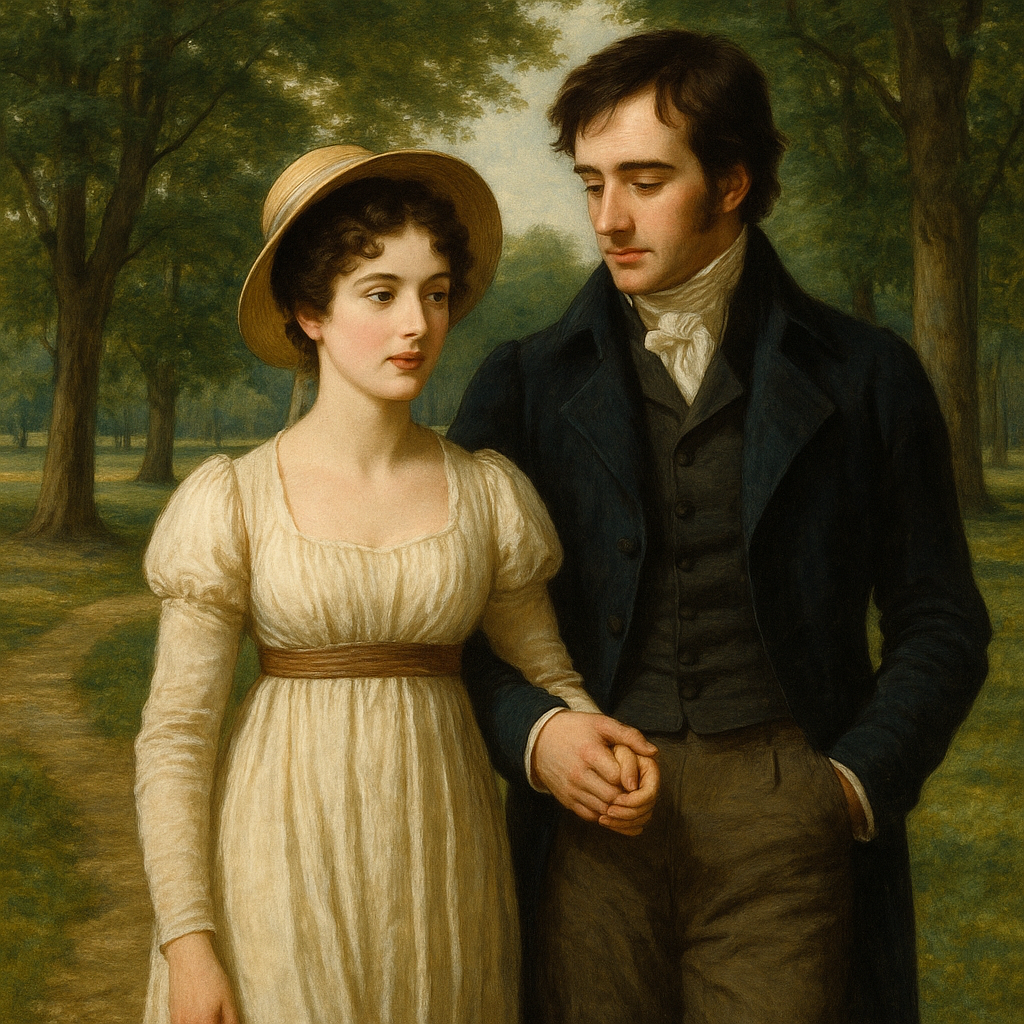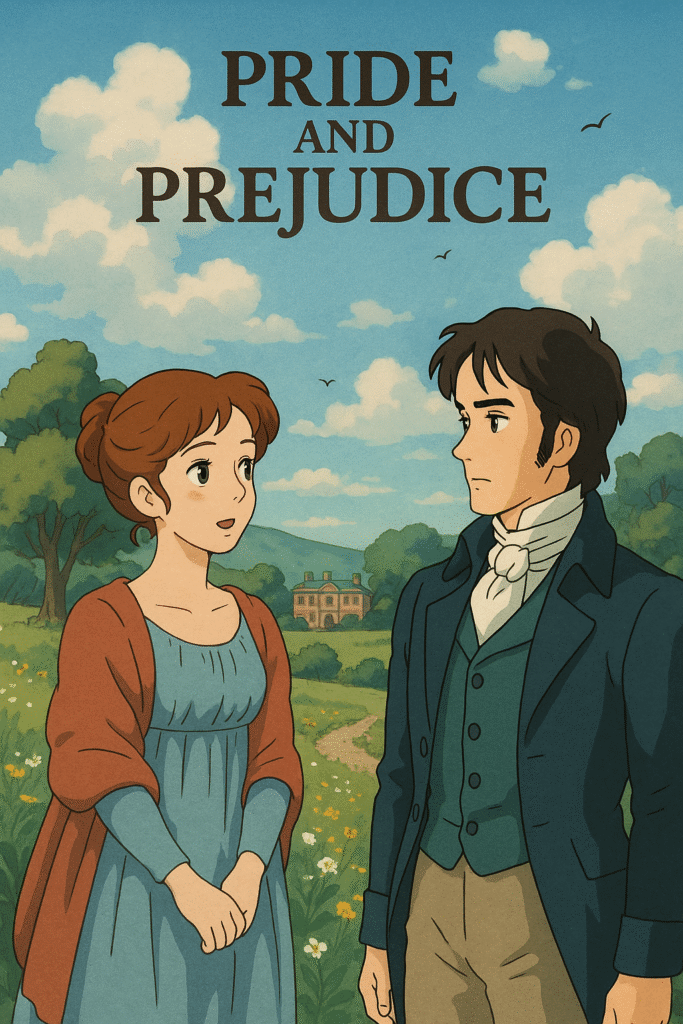
Pride and Prejudice Summary

Introduction to Pride and Prejudice
Jane Austen’s “Pride and Prejudice,” first published in 1813, is not just a romantic novel; it serves as a keen social commentary on the early 19th century in England. Set against the backdrop of the Regency era, the narrative vividly illustrates the intricacies of social class, marriage, and morality. Austen pioneered the development of the novel as a genre, employing irony and wit while exploring the themes that remain relevant even today. The initial reception of “Pride and Prejudice” was largely positive, although its intricate examination of society’s expectations was sometimes misunderstood. The novel’s enduring popularity can be attributed to its rich characterizations and the timeless conflict between personal integrity and societal pressure.
The central narrative unfolds through the experiences of Elizabeth Bennet, the protagonist whose journey towards personal growth and self-discovery serves as a primary focus throughout the text. The themes of love and social class are intricately woven into the fabric of the storyline, illustrating not only the romantic entanglements of the characters but also the broader societal structures that influence their choices. Elizabeth’s spirited nature and critical observation of her society challenge the status quo of her time, setting a foundation for the exploration of self-worth versus societal expectations.
The motif of personal growth is prominent as Elizabeth learns to navigate her prejudice and misjudgments, particularly in relation to Mr. Darcy, a character whose initial portrayal may lead one to form a negative opinion that he ultimately transcends. Austen’s skillful character development and themes of misunderstanding and eventual enlightenment resonate profoundly with readers, further solidifying its status as a literary classic. Ultimately, “Pride and Prejudice” not only offers a glimpse into historical social customs but continues to engage its audience through the relatability of its themes.
Main Characters and Their Roles in Pride and Prejudice
Pride and Prejudice, a novel by Jane Austen, is renowned for its cast of engaging characters, particularly the protagonists Elizabeth Bennet and Mr. Fitzwilliam Darcy. Elizabeth, the intelligent and spirited second daughter of the Bennet family, serves as the novel’s primary heroine. Her wit and ability to challenge societal norms set her apart as an early feminist figure in literature. As the story progresses, Elizabeth’s journey of self-discovery and changing perceptions, particularly concerning Mr. Darcy, exemplifies the themes of pride, prejudice, and the societal expectations placed on women in the 19th century.
Mr. Darcy, initially portrayed as aloof and prideful, plays a crucial role in the narrative arc. His character develops significantly; through interactions with Elizabeth, he reveals a more nuanced personality. The complexities of Mr. Darcy’s pride are explored, as he confronts his prejudices against those of a lower social standing and realizes the importance of love and respect over class considerations. This evolution enriches the novel’s exploration of personal growth and the influence of societal standards on individual behavior.
In addition to the main characters, supporting figures such as Mr. Charles Bingley and Jane Bennet further enhance the narrative. Mr. Bingley’s affable nature and wealth provide a stark contrast to Mr. Darcy, allowing exploration of relationships across different social strata. Jane, Elizabeth’s elder sister, epitomizes kindness and social grace, representing ideals of femininity while also undergoing her own emotional trials. Lydia Bennet, on the contrary, embodies youthful impulsiveness and recklessness, which serves as a foil to Elizabeth’s maturity. The interplay between these characters and their distinct roles enriches the plot and underscores Austen’s commentary on class, marriage, and moral fortitude within the context of early 19th-century England.
Plot Summary of Pride and Prejudice
“Pride and Prejudice,” authored by Jane Austen, revolves around the life of Elizabeth Bennet, the second of five daughters in a landed gentry family. The plot begins with the arrival of the wealthy and eligible bachelor, Mr. Bingley, at Netherfield Park, unsettling the local social dynamics. The ensuing excitement among the Bennet sisters is palpable, particularly from the perspective of Jane, Elizabeth’s elder sister, who quickly draws Mr. Bingley’s attention. However, his close friend, Mr. Darcy, a proud and aloof gentleman, ignites Elizabeth’s disdain with his haughty demeanor.
As the narrative unfolds, a pivotal event occurs at the Netherfield ball, where Mr. Darcy’s initial slighting of Elizabeth solidifies her prejudice against him. The turning point arrives with Mr. Collins’s comically awkward proposal, which Elizabeth vehemently rejects, much to her mother’s chagrin. This rejection leads to further complications, particularly after Mr. Wickham, a charming officer, falsely tells Elizabeth about Darcy’s supposed wrongdoings. This misinformation intensifies Elizabeth’s aversion towards Mr. Darcy, serving as an example of societal expectations influencing her perceptions.
The plot thickens when Mr. Darcy ultimately proposes to Elizabeth, only to be met with outrage due to his earlier actions and the rumors surrounding him. However, this moment marks a turning point, as Darcy provides her with a letter that explains his past and sheds light on Wickham’s true character. This revelation prompts a shift in Elizabeth’s feelings, leading to a gradual acknowledgment of Mr. Darcy’s genuine nature. Their relationship culminates in mutual understanding and respect, ultimately culminating in a second proposal that Elizabeth joyously accepts. The resolution of their romantic tension underscores the themes of character development and societal expectations throughout the story, showcasing Austen’s critique of the social norms of her time.
Themes and Analysis

One of the most salient themes in Jane Austen’s ‘Pride and Prejudice’ is the critique of social class and the institution of marriage. The novel is set in early 19th century England, during a time when class distinctions held considerable weight in society. Through the experiences of the protagonist, Elizabeth Bennet, and her interactions with characters such as Mr. Darcy, Austen adeptly illustrates the restrictive nature of social hierarchies and how they influence personal relationships. The focus on marriage transcends romantic ideals, often serving as a pragmatic necessity for women seeking security and social standing. Elizabeth’s initial prejudice against Mr. Darcy, rooted in his perceived arrogance and wealth, unveils the complexities of their eventual attraction and challenges societal norms.
Additionally, personal character and moral development are vital aspects of the narrative. The journey toward self-awareness is prominently featured, particularly in Elizabeth’s evolution from initial judgments—fueled by pride and prejudice—to a more discerning and mature perspective. Mr. Darcy, initially portrayed as a proud figure, undergoes significant transformation as he confronts his flaws and prioritizes genuine connections over social expectations. This evolution embodies the novel’s deeper moral undertones, advocating for personal growth and the reevaluation of one’s biases.
Moreover, Austen’s use of irony and wit serves to enrich the text, allowing readers to engage critically with the satirical portrayal of societal norms. The humor inherent in certain dialogues and situations underscores the absurdities of class distinctions and romantic pursuits, making the critique both insightful and entertaining. Ultimately, the relevance of ‘Pride and Prejudice’ to contemporary society remains striking, as issues of surface-level judgments and the complexities of relationships continue to resonate. Austen’s masterful exploration of pride, prejudice, and the pursuit of self-awareness invites reflection on these timeless themes through the lens of character transformations within the narrative.
Pride and Prejudice, by Jane Austen, is a romantic novel set in early 19th-century England that explores themes of love, class, family, and reputation. It follows the spirited and intelligent Elizabeth Bennet as she navigates societal expectations and her own evolving feelings.
The Bennet family has five daughters and no sons, meaning their estate will pass to a distant male relative, Mr. Collins. Because of this, their mother is determined to see all the girls married well, especially to wealthy men.
The story begins when the wealthy and eligible Mr. Bingley rents Netherfield Park, a nearby estate. He arrives with his sisters and his friend, the even richer but aloof Mr. Fitzwilliam Darcy. At a local ball, Bingley is immediately taken with the eldest Bennet daughter, the sweet and beautiful Jane. Darcy, however, snubs Elizabeth by refusing to dance with her, which offends her and begins a rocky relationship between them.
As the social season unfolds, Darcy begins to admire Elizabeth’s wit and intelligence, though his reserved nature and social pride get in the way. Meanwhile, Elizabeth’s dislike for him grows, fueled by his apparent arrogance and her conversations with a charming officer, Mr. Wickham. Wickham tells Elizabeth that Darcy wronged him, deepening her resentment.
Mr. Collins, a pompous clergyman and heir to the Bennet estate, proposes to Elizabeth, but she refuses. He quickly turns his attention to her friend Charlotte Lucas, who accepts him for financial security.
Jane’s romance with Bingley seems promising, but suddenly he leaves town without explanation. Elizabeth later learns that Darcy influenced Bingley’s decision to abandon Jane, believing her feelings weren’t strong and that her family was beneath him.
Tensions peak when Darcy unexpectedly proposes to Elizabeth. She is shocked and offended, rejecting him harshly and accusing him of both separating Jane and Bingley and mistreating Wickham. The next day, Darcy writes Elizabeth a letter explaining his side: Bingley’s departure was out of concern for his friend, and Wickham is actually the one at fault—he tried to elope with Darcy’s young sister for her fortune.
This revelation shakes Elizabeth’s prejudices and begins to shift her opinion of Darcy.
Months later, while visiting Darcy’s estate with her aunt and uncle, Elizabeth is surprised by his warmth and hospitality. Their relationship begins to thaw. Then, disaster strikes when her youngest sister Lydia elopes with Wickham. The scandal threatens the entire family’s reputation, but Darcy secretly intervenes, finds the couple, and ensures they marry, preserving the Bennets’ honor.
Soon after, Bingley returns and resumes his courtship of Jane, leading to a proposal. Darcy also proposes to Elizabeth again—this time humbly—and she joyfully accepts, now understanding his true character and recognizing her own misjudgments.
The novel ends with the double wedding of Jane and Bingley, and Elizabeth and Darcy. Through their journey, Austen satirizes social class, marriage, and human folly, while also crafting a timeless love story grounded in personal growth, understanding, and mutual respect.
